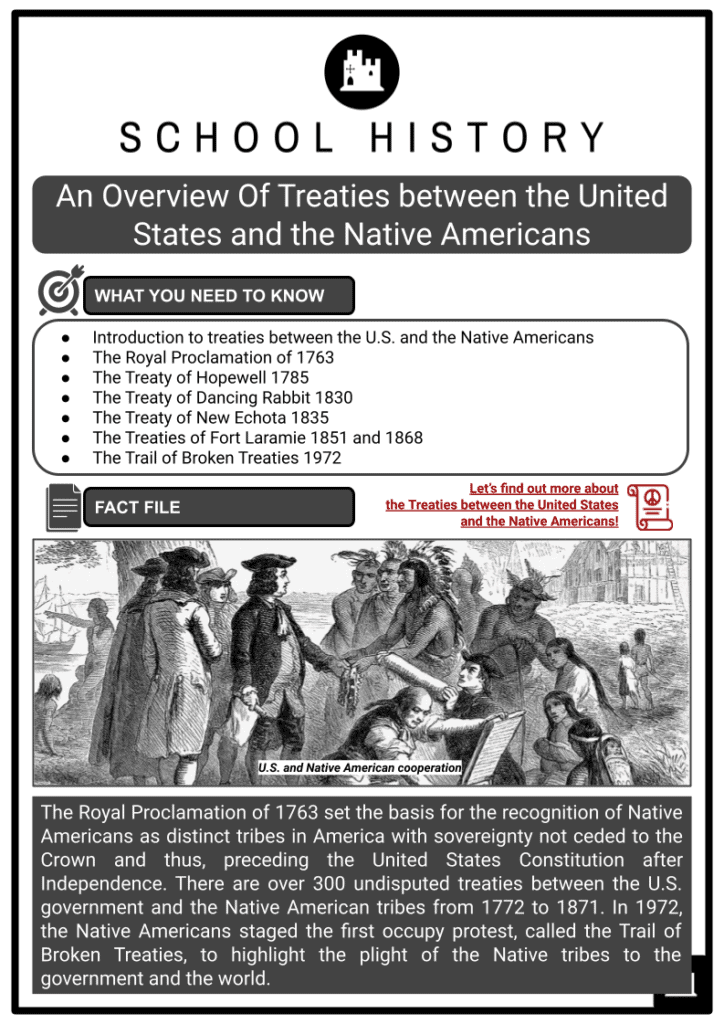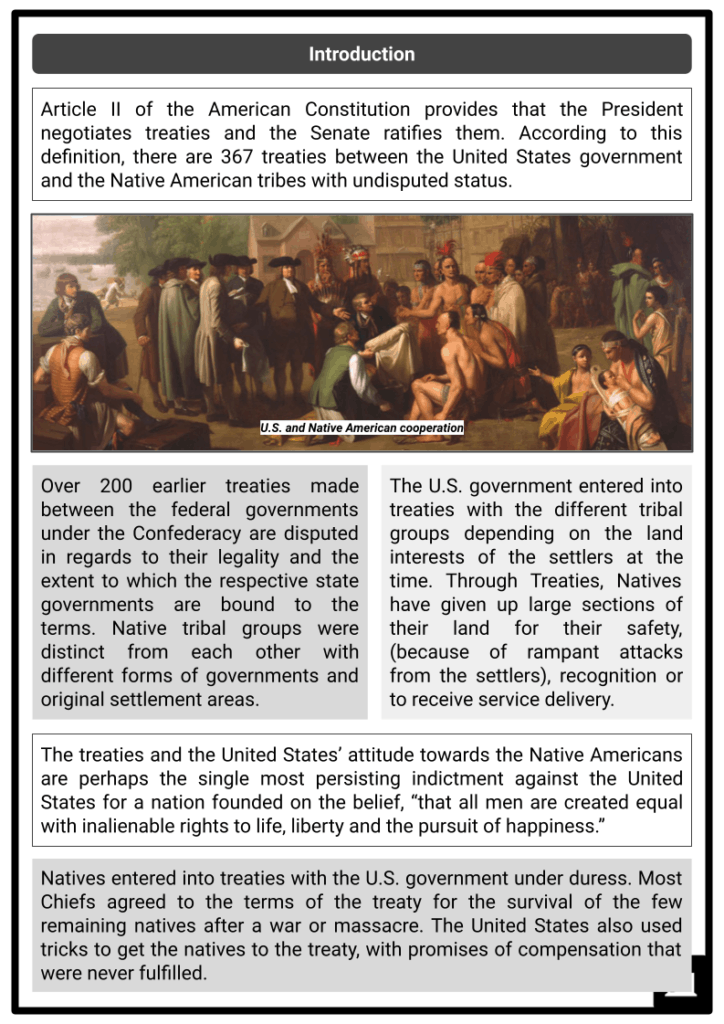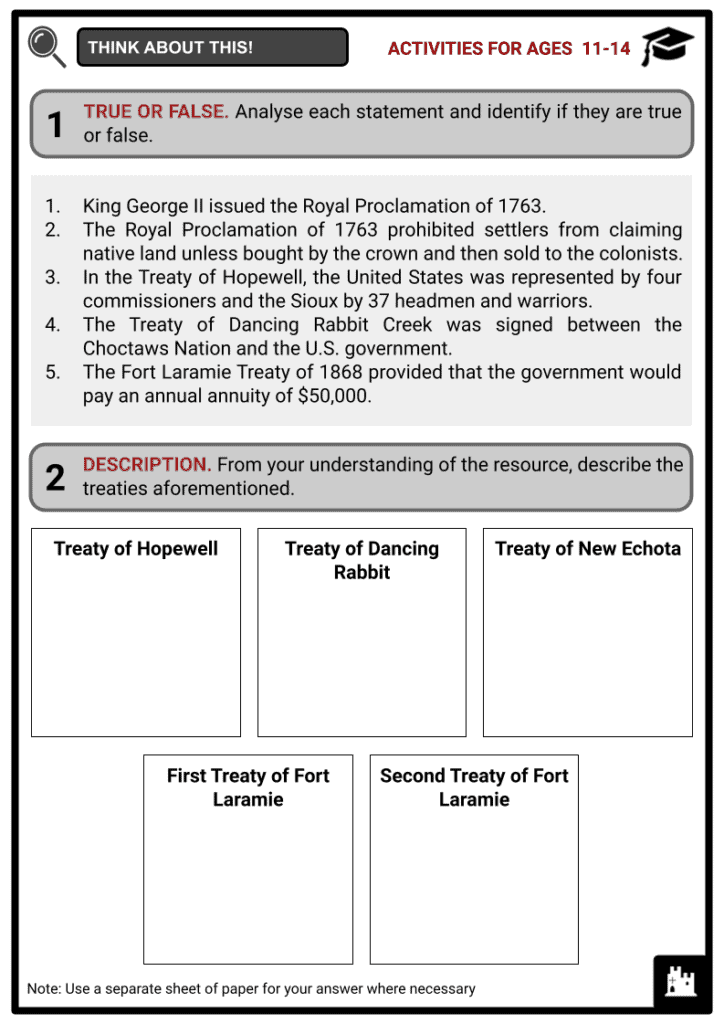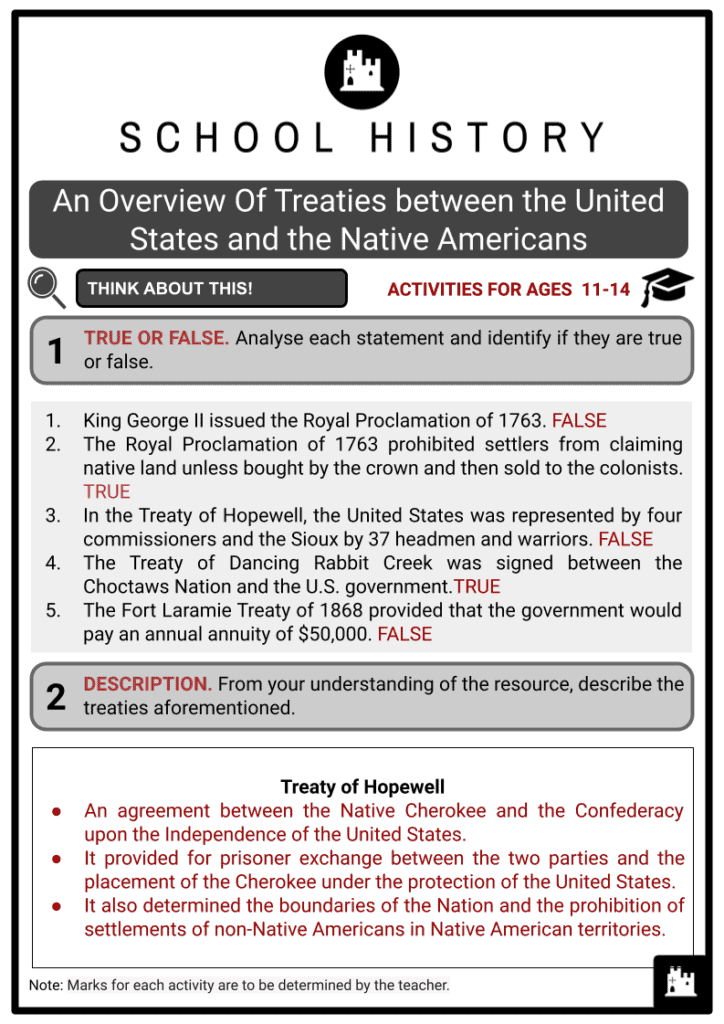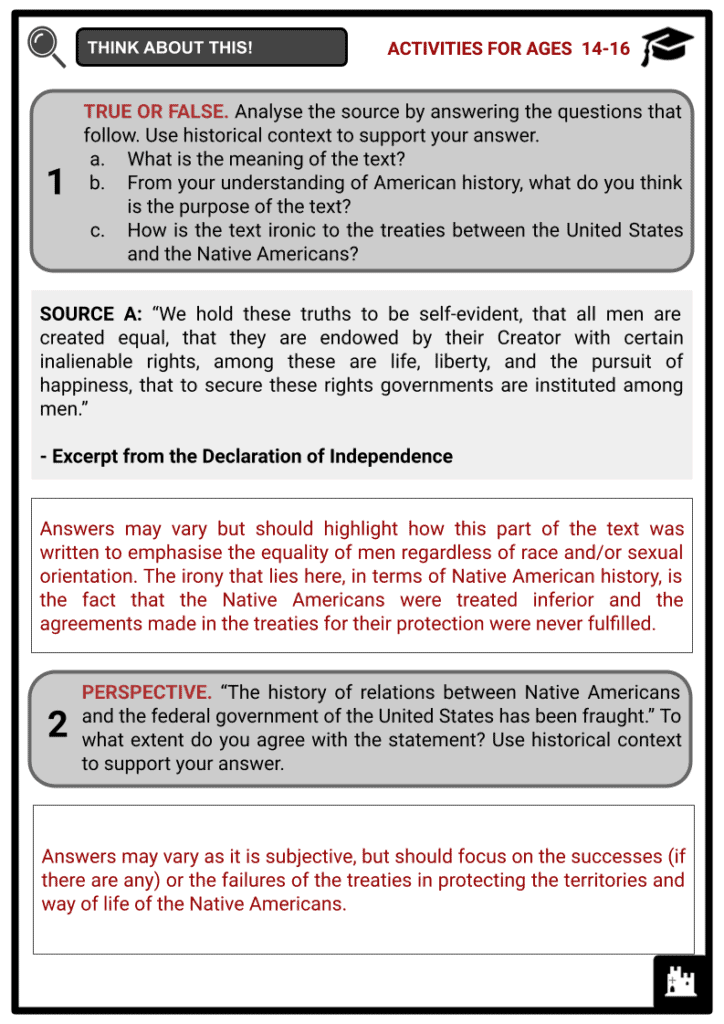Download An Overview Of Treaties between the United States and the Native Americans
Do you want to save dozens of hours in time? Get your evenings and weekends back? Be able to teach An Overview Of Treaties between the United States and the Native Americans to your students?
Our worksheet bundle includes a fact file and printable worksheets and student activities. Perfect for both the classroom and homeschooling!
Table of Contents
Add a header to begin generating the table of contents
Summary
- Introduction to treaties between the U.S. and the Native Americans
- The Royal Proclamation of 1763
- The Treaty of Hopewell 1785
- The Treaty of Dancing Rabbit 1830
- The Treaty of New Echota 1835
- The Treaties of Fort Laramie 1851 and 1868
- The Trail of Broken Treaties 1972
Key Facts And Information
Let’s find out more about An Overview Of Treaties between the United States and the Native Americans!
- The Royal Proclamation of 1763 set the basis for the recognition of Native Americans as distinct tribes in America with sovereignty not ceded to the Crown and thus, preceding the United States Constitution after Independence. There are over 300 undisputed treaties between the U.S. government and the Native American tribes from 1772 to 1871. In 1972, the Native Americans staged the first occupy protest, called the Trail of Broken Treaties, to highlight the plight of the Native tribes to the government and the world.
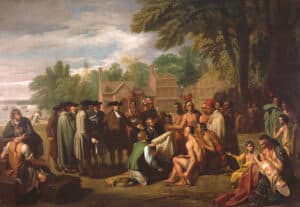
Introduction
- Article II of the American Constitution provides that the President negotiates treaties and the Senate ratifies them. According to this definition, there are 367 treaties between the United States government and the Native American tribes with undisputed status.
- Over 200 earlier treaties made between the federal governments under the Confederacy are disputed in regards to their legality and the extent to which the respective state governments are bound to the terms. Native tribal groups were distinct from each other with different forms of governments and original settlement areas.
- The U.S. government entered into treaties with the different tribal groups depending on the land interests of the settlers at the time. Through Treaties, Natives have given up large sections of their land for their safety, (because of rampant attacks from the settlers), recognition or to receive service delivery.
- The treaties and the United States’ attitude towards the Native Americans are perhaps the single most persisting indictment against the United States for a nation founded on the belief, “that all men are created equal with inalienable rights to life, liberty and the pursuit of happiness.”
- Natives entered into treaties with the U.S. government under duress. Most Chiefs agreed to the terms of the treaty for the survival of the few remaining natives after a war or massacre. The United States also used tricks to get the natives to the treaty, with promises of compensation that were never fulfilled.
Timeline
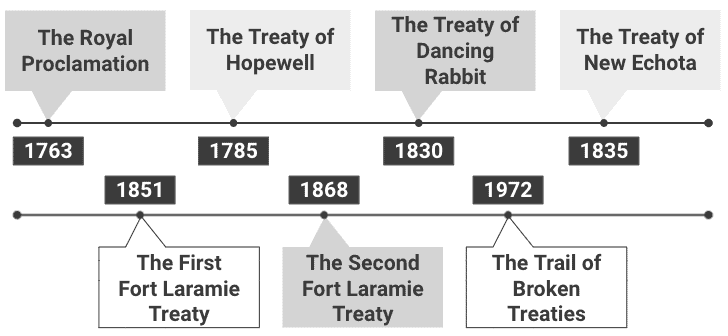
The Royal Proclamation of 1763
- Upon the conclusion of the French and Indian wars with the victory of Britain, King George III issued the royal proclamation, which forms the cornerstone of Native American Indians or Aboriginal (as known in Canada) rights and law. The proclamation created what is presently referred to as the Proclamation Line by organising Britain’s territories in the North American region into “Quebec, East and West Florida, and Grenada and the Indian reservation west of the Appalachians, from the south the Hudson Bay to the north of Florida.”
- The Proclamation was an official claim of England to the North American region. In the proclamation, the King states, among other things, that Native titles “exists and continues to exist, until ceded by treaty.” The proclamation prohibited settlers from claiming native land unless bought by the crown and then sold to the colonists.
- It further restricted movement and trade westwards unless by traders licensed by the crown. The proclamation was in effect a prohibition of westward expansion by the colonists until Thomas Jefferson commissioned the expedition of Louisiana and other events that necessitated the “the great leap westward”.
- The Royal proclamation thus set the basis of treaties between the U.S. and the Native Americans tribes. What follows is an overview of the most prominent treaties between the Natives and the Americans.
The Treaty of Hopewell 1785
- Treaty of Hopewell was an agreement between the Native Cherokee and the Confederacy upon the Independence of the United States. The United States was represented by four commissioners and the Cherokee by 37 headmen and warriors and was signed on the banks of Keowee River in 1785.
- It provided for prisoner exchange between the two parties and the placement of the Cherokee under the protection of the United States. It also determined the boundaries of the Nation and the prohibition of settlements of non-Native Americans in Native American territories.
- It further provided for extradition of non-Native American criminals to the U.S. for punishment (but not trial), the supremacy of the US in trade regulation and provision of an Native American deputy to the Congress, and peace and friendship between the Cherokee and the Natives.
- Due to rampant disregard for the treaty, the Cherokee labelled the U.S. talking leaves, owing to the fleeting nature of their promises in treaties. Soon after, the Cherokee noted that at least 3,000 settlers were on their side of the Territory bordering the then State of Franklin, leading to a dispute that was settled by the Treaty of Houston in 1791.
The Treaty of Dancing Rabbit 1830
- The Treaty of Dancing Rabbit Creek signed between the Choctaws Nation and the U.S. government and ratified by the Senate in 1830 saw the Natives cede over 10 million acres of land to the U.S. government. It was the first treaty signed after the Indian Removal Act of 1830 and resulted in the creation of the Mississippi territory in 1798.
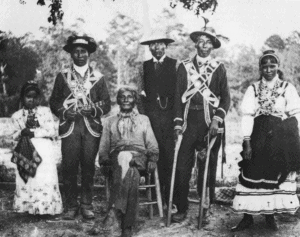
- The election of Andrew Jackson as President negatively affected Native Americans for he had an open stand against land and collective rights of the Natives. In 1829, before his inauguration, Georgia, Alabama, and Mississippi State passed “extension laws” extending the jurisdiction of the state over Native American Territories within their borders, counting on the support of the President. The laws outlawed Native American governments and communal land tenure and declared that Native Americans were state citizens.
- The President sent Commissioners John Coffee and John Eaton to negotiate the transfer of title and resettlement to present-day Oklahoma and Kansas as provided by the Indian Removal Act. Choctaws women leaders, whose authorities superseded the Chiefs, refused the terms of the treaty on two occasions with the consensus of the whole community.
- The commissioners called off the negotiations and instead, met the Chiefs who agreed to specific treaty terms which included provisions of Choctaw men and their families to claim title to specific allotment of land in Mississippi as citizens. The treaty was also supposed to allow the Chiefs who signed it, plus their families and other Native Americans in support of the Removal, extra land allocations.
- The Native Americans were given three years to vacate the territory, but the extra land claims in the treaty were not realised owing to corruption and incompetence of the land agents such as William Ward, acting for the U.S. at the time.
The Treaty of New Echota 1835
- In 1830, gold was discovered in the north of Georgia, an area of land at the time occupied by the Cherokee Nation. The federal government opened negotiations with the Cherokee people under the leadership of Chief John Ross, Chief Ridge, and other chiefs, who agreed to cede their land in exchange for $5 million.
- The Senate ratified the treaty but the Cherokee nation rejected it, citing that the Chiefs’ actions were not representative of the people’s will. This caused their forcible removal in 1838 and the Trail of Tears to Oklahoma Territory. The Cherokee assassinated the leadership that agreed to the treaty.
The Treaties of Fort Laramie 1851 and 1868
- The treaties of Fort Laramie were mostly in response to the regular inter-conflicts between the Native Americans and the settlers. The 1851 agreement is among the contributors to the erosion of the Permanent Indian Frontier as established by President Jackson, as it provided for the safe passage of migrants through the Territory including railroad surveyors.
- The treaty also provided that the Natives would allow the U.S. government to build roads and army posts on their land and pay compensation to the government for violation of treaty terms. The treaty provided that the government would pay an annual annuity of $50,000.
- Enforcing the treaty was problematic on the side of the settlers and the Native Americans. The treaty was written in English, thus not many Natives understood it. Furthermore, not many tribal groups agreed to its terms. The settlers also did not adhere to the terms of the treaty and settled past the Oregon Trail without the intervention of the U.S. army that had set up forts on the trail to protect the Native and the settlers from each other.
- The second Fort Laramie Treaty of 1868 was due to the Red Cloud’s War and the Fetterman’s Massacre. The U.S. government realised that they had underestimated the army required to defeat the Sioux (a Native American tribe) and had discovered another path to the gold in Montana. The government contracted to close the Bozeman Trail, a shortcut to the Montana goldfields, and the forts along it. Chief Red Cloud arranged to move his people to the Great Sioux Reservation in Dakota.
- Ultimately, the terms of the Fort Laramie treaty were met with limited success. Inter-tribal fighting continued amongst the Native Americans and migrants continued to trespass Native American Territory. In 1874, gold was discovered in the Black Hills and the government once again offered to buy the land, but the Sioux tribes refused to, leading to the Great Sioux War from 1876 to 1877.
The Trail of Broken Treaties 1972
- Different organisations with the objective of advocating for the rights of Native Americans organised a caravan of protests from North America to the capital of Washington, D.C. in 1972 to meet with the government and discuss the needs of the Natives.
- The Natives had prepared a twenty-point position paper, but the Nixon administration refused to meet the protestors. For a week, the protestors occupied the Department of Interior headquarters where the Bureau of Indian Affairs was located until the federal government sent leaders to negotiate with the protestors.
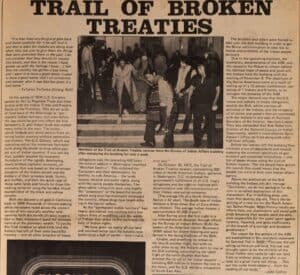
- The following is a summary of the twenty point demands raised in the position paper:
- The U.S. government should revoke sections of the 1871 Indians Appropriations Act that removed the power of the Native American Nations to contract through constitutionally bound treaties with the U.S. government.
- The U.S. government should establish a Treaty Commission with powers to enter into treaties with Native Americans to safeguard the posterity of the Native American Nations. No action of the U.S. government should vacate any term of existing treaties.
- The federal government should pledge to meet with four Native American representatives on 2 June 1974, to discuss the future of Native American Nations, in the presence of the media.
- The President should establish a committee of Native Americans and non-Native Americans to examine treaty commitments and violations and produce an advisory report for adoption and further action.
- Treaties not ratified are to be presented before the Senate for ratification.
- All Native American people should be considered in treaty relations with the federal government.
- The federal government should ensure judicial enforcement and protection of treaty rights of Native Americans.
- The federal government should establish a system of federal courts through which Native Americans can seek redress against treaties and tribal rights with the participation of Native Americans in the interpretation of treaties. The jurisdiction of these courts will apply to issues between Native Americans and non-Native Americans.
- The United States Congress relinquished its control over Indian Affairs and established a joint committee (Congress and Native American representatives) to be called the “Committee on Reconstruction of Indian Relations and Programs” with the mandate of restructuring Native American relations in America.
- By July 1976, the federal government had restored a permanent Native American land area of not less than 110 million acres. The land should be perpetually non-taxable by the federal government and the termination of Acts of 1950–60s repealed.
- The role of Native American membership tribes in 25 U.S.C. 163 should be revised to include an individual who lost tribal status due to enrollment challenges and the ability for individuals to register in more than one tribe and receive double benefits, in reflection to the interconnected nature of the Native tribes.
- Congress to repeal state laws passed under the Public Law 280 which allows for non-Native Americans to gain access and control over reservation areas undermining the sovereignty of the tribes.
- Offences against Native Americans to be treated as federal crimes and offenders must stand trial under federal laws. Congress should establish the federal Native American grand jury consisting of Native Americans appointed by the president with the participation of the Native Americans whose jurisdiction covers non-Native Americans in Native American reservations.
- The dismantling of the Bureau of Indian Affairs by 1976 and establishment of a new government structure that accurately maintains Native American-Federal relationships.
- The new office once the Bureau is dismantled is to be called the Office of Federal Indian Relations and Community Reconstruction.
- Among the mandates of the Office of Federal Indian Relations and Community Reconstruction should be the promotion of equality between Native American Nations and federal government and to find mechanisms to remedy historical injustices by the federal government against the Native Americans.
- Congress should enact a statute enabling trade, commerce, and transportation of Native Americans outside the jurisdiction of the federal government and the immunity from taxation state and federal of Native Americans in reservations.
- The U.S. government should recognise and protect the spiritual and cultural integrity of the Native American Nations.
- Mechanism of Native American organisations should be consolidated to unify Native American Nations.
- The U.S. should commit to improving and creating better standards of housing, education, employment, and economic development for Native Americans.

